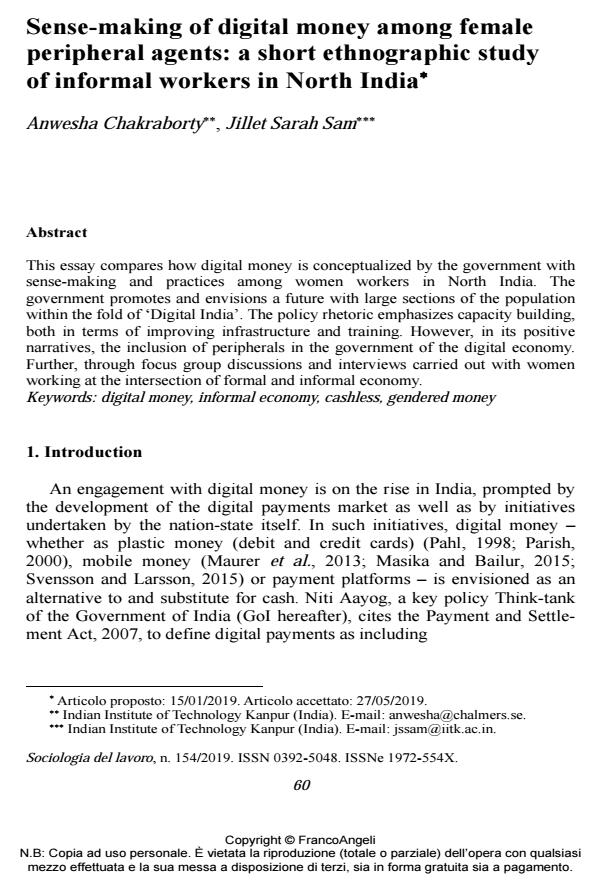Sense-making of digital money among female peripheral agents: a short ethnographic study of informal workers in North India
Journal title SOCIOLOGIA DEL LAVORO
Author/s Anwesha Chakraborty, Jillet Sarah Sam
Publishing Year 2019 Issue 2019/154
Language English Pages 19 P. 60-78 File size 197 KB
DOI 10.3280/SL2019-154004
DOI is like a bar code for intellectual property: to have more infomation
click here
Below, you can see the article first page
If you want to buy this article in PDF format, you can do it, following the instructions to buy download credits

FrancoAngeli is member of Publishers International Linking Association, Inc (PILA), a not-for-profit association which run the CrossRef service enabling links to and from online scholarly content.
This essay compares how digital money is conceptualized by the government with sense-making and practices among women workers in North India. The government promotes and envisions a future with large sections of the population within the fold of ‘Digital India’. The policy rhetoric emphasizes capacity building, both in terms of improving infrastructure and training. However, in its positive narratives, the inclusion of peripherals in the government of the digital economy. Further, through focus group discussions and interviews carried out with women working at the intersection of formal and informal economy.
Keywords: Digital money, informal economy, cashless, gendered money
- Addressing corruption through visual tools in India: the case of three civil society initiatives and their Facebook pages Anwesha Chakraborty, Alice Mattoni, in Visual Studies /2023 pp.803
DOI: 10.1080/1472586X.2023.2239759 - Improving Transparency in Service Delivery to Fight Corruption? Mapping Multi-Stakeholder Voices on Digitization in the Indian Public Healthcare Sector Anwesha Chakraborty, Ina Kubbe, in American Behavioral Scientist 00027642241268555/2024
DOI: 10.1177/00027642241268555 - Off-platform Social Networks and Gig Work During the COVID-19 Pandemic in India Rajorshi Ray, Jillet Sarah Sam, in Journal of South Asian Development /2023 pp.359
DOI: 10.1177/09731741231191876
Anwesha Chakraborty, Jillet Sarah Sam, Sense-making of digital money among female peripheral agents: a short ethnographic study of informal workers in North India in "SOCIOLOGIA DEL LAVORO " 154/2019, pp 60-78, DOI: 10.3280/SL2019-154004